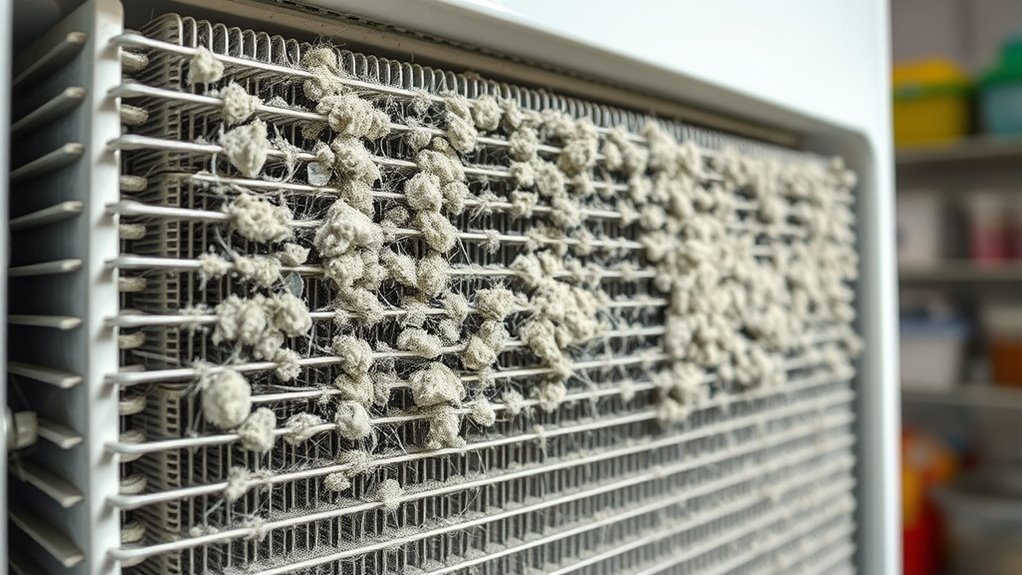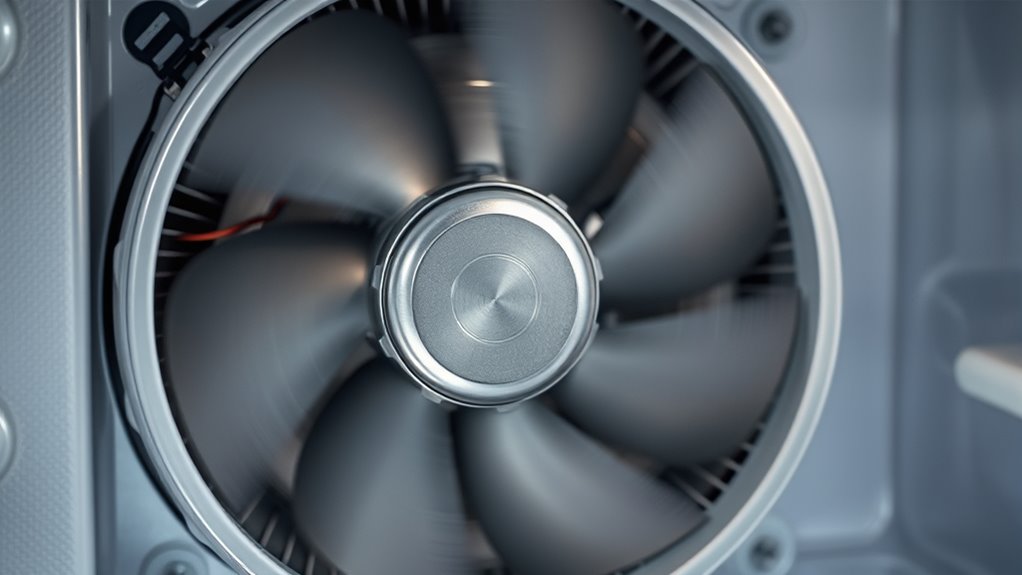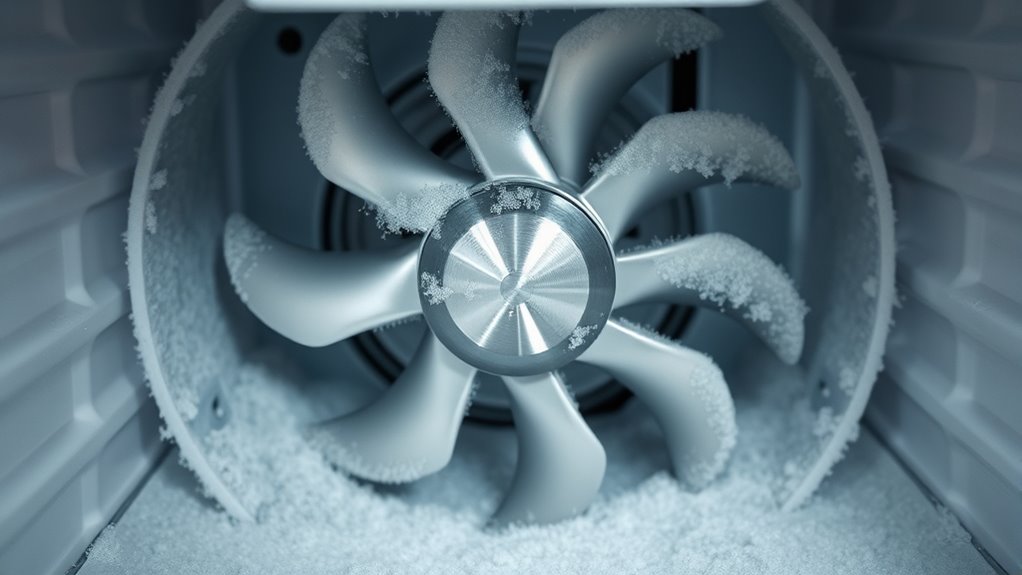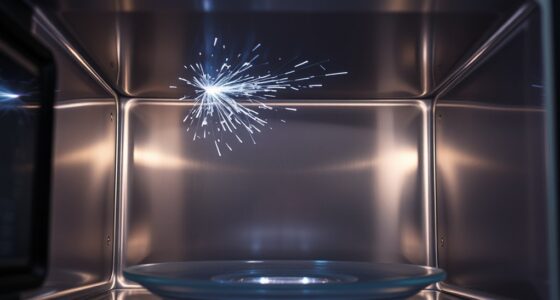If your refrigerator isn’t cold enough, start by checking if the temperature is set between 37°F and 40°F and adjust if needed. Confirm vents inside are clear and not blocked, and verify that door seals are tight. Clean the condenser coils and make sure the fan and compressor are working properly. If issues persist, other problems might be involved. Keep exploring to learn how each step can help restore proper cooling.
Key Takeaways
- Verify and adjust the thermostat to ensure it’s set between 37°F and 40°F, allowing 24 hours to stabilize.
- Clean the condenser coils, air vents, and drain hole to promote proper airflow and cooling efficiency.
- Check that the evaporator and condenser fans are functioning smoothly and free of dust or debris.
- Ensure the refrigerator is level, properly placed away from heat sources, and not overpacked to maintain airflow.
- If issues persist, contact a professional technician to diagnose potential hardware failures like compressor or fan problems.
Checking the Temperature Settings

If your refrigerator isn’t cold enough, the first step is to check the temperature settings. Start by ensuring the thermostat is set to the recommended range, usually between 37°F and 40°F. Sometimes, the temperature calibration is off, causing the fridge to run warmer than intended. Adjust the thermostat dial or control panel accordingly, turning it to a colder setting. After making adjustment, give the fridge some time—at least 24 hours—to reach the new temperature. Remember, inaccurate temperature calibration can lead to inconsistent cooling. If adjusting the thermostat doesn’t solve the issue, double-check that the control is functioning properly, as a faulty thermostat can also prevent your fridge from maintaining the correct temperature. Additionally, understanding how temperature calibration affects overall performance can help identify underlying issues, especially since proper calibration is crucial for home appliance efficiency. Regular maintenance and proper ventilation around the appliance can also help improve cooling performance. Ensuring proper airflow and proper insulation are essential for consistent cooling and energy efficiency, which can also be influenced by security measures that prevent external factors from affecting your appliances.
Ensuring Proper Air Circulation Inside the Fridge

Make sure your air vents are clear so cold air can circulate freely. Avoid overpacking your fridge, as crowded shelves block airflow and reduce cooling efficiency. Regularly clean the interior to remove dust and debris that can hinder proper air movement. Additionally, ensure proper air circulation by avoiding placing the refrigerator in areas with high humidity or poor ventilation air purifier maintenance. Proper placement and energy-efficient design can also help maintain optimal cooling performance. Checking for any malfunctioning components like the thermostat or compressor can further improve cooling efficiency. Ensuring adequate air circulation within the fridge is essential for maintaining consistent cold temperatures.
Clear Air Vents
Ensuring that your refrigerator’s air vents are clear is essential for maintaining proper temperature and food freshness. Blocked or dusty vents hinder air circulation, causing cold air to stay trapped and warm air to linger. Check the vent placement inside your fridge and remove any items blocking airflow. Keep vents unobstructed to allow even distribution of cold air throughout the appliance. Proper air circulation prevents hot spots and helps maintain a consistent temperature, which is vital for food preservation. Regularly clean and dust the vents to prevent buildup that can restrict airflow. Additionally, airflow efficiency is crucial for preventing temperature fluctuations that can lead to spoiled food. By keeping your air vents clear, you guarantee the refrigerator’s cooling system functions efficiently, reducing the risk of inadequate cooling and keeping your food fresh longer. Regular maintenance of vents also contributes to the energy efficiency of your appliance, saving you money on electricity bills.
Avoid Overpacking Items
Overpacking your fridge can block air circulation and lead to uneven cooling. Proper food storage and refrigerator organization are key to maintaining consistent temperatures. When your fridge is packed tightly, cold air can’t circulate freely around your food, causing some items to stay warmer than others. To prevent this, avoid overpacking by leaving space between items. Arrange food so that air vents remain clear, and don’t block the airflow with jars or tall containers. Keep frequently accessed items at the front for convenience. A well-organized fridge not only improves cooling efficiency but also helps you identify spoiled or expired food quickly. Remember, a less crowded fridge guarantees better air circulation and keeps everything properly cooled. air circulation is essential for an efficient cooling process inside your refrigerator.
Regularly Clean Interior
Regularly cleaning the interior of your fridge is essential for maintaining proper air circulation. When you keep your food storage areas tidy, you prevent overcrowding that can block vents and restrict airflow. Remove expired or spoiled items to reduce clutter and create space for cold air to circulate evenly. Organize your interior so that airflow isn’t obstructed by large containers or stacked items. Wipe down shelves and walls to eliminate spills and debris that can interfere with temperature regulation. Proper interior organization helps ensure cold air reaches all areas of your fridge, keeping everything at a consistent temperature. Additionally, airflow management techniques, such as using proper storage containers, can further enhance cooling efficiency. Regular cleaning and thoughtful food storage help your refrigerator operate efficiently, preventing warm spots and ensuring your food stays fresh longer. Nanotechnology-enabled coatings can even help improve the efficiency of cooling surfaces within appliances. Maintaining optimal airflow is also crucial for preventing temperature inconsistencies, ensuring your refrigerator functions effectively. Using ventilation optimization methods can further improve overall cooling performance. Incorporating air circulation accessories, like fans or vents, can also help distribute cold air more evenly throughout the unit.
Inspecting the Door Seals for Leaks

To check if your refrigerator door seals are causing cooling issues, start by inspecting the door gasket carefully. Look for cracks, tears, or gaps where air might escape. Perform a leak detection by closing the door on a dollar bill or piece of paper; if it slips out easily, the seal isn’t tight. A faulty door gasket allows warm air in, reducing cooling efficiency. Use this table to guide your inspection:
| Step | What to Check | How to Fix |
|---|---|---|
| Visual Inspection | Cracks, tears, warping | Replace the door gasket if damaged |
| Leak Detection | Ease of paper removal | Clean or replace gasket to ensure a seal |
| Seal Tightness | Air gaps around edges | Adjust or replace gasket as needed |
Additionally, ensuring the gasket maintains proper door seal integrity is essential for optimal refrigerator performance.
Cleaning the Condenser Coils

First, locate your condenser coils, usually at the back or underneath your fridge. Next, remove dust buildup using a gentle brush or vacuum attachment. Finally, clean the coils carefully with soft tools to prevent damage and guarantee maximum cooling. Regular maintenance of the coils can also help prevent overheating and improve efficiency through proper cleaning techniques.
Locate Condenser Coils
Condenser coils are usually located either on the back or the bottom of your refrigerator. To find the condenser coil location, look for a series of thin, metal tubes, often covered by a panel or grille. Once located, you can proceed with coil cleaning techniques to keep your fridge running efficiently. Here are some tips:
- Check behind the refrigerator if it’s not at the bottom.
- Inspect beneath the kickplate or grille on the front.
- Remove any panels or covers carefully.
- Look for dust, pet hair, or debris on the coils.
- Use a brush or vacuum for thorough cleaning.
Knowing where the condenser coils are helps you perform regular maintenance and prevent cooling issues. Proper coil cleaning techniques ensure your refrigerator stays cold and operates smoothly.
Remove Dust Buildup
Dust buildup on the condenser coils can substantially reduce your refrigerator’s cooling efficiency. Over time, dust accumulation causes airflow obstruction, making the coils work harder and decreasing cooling performance. To prevent this, regularly clean the coils to remove dust and debris. Use a coil brush or vacuum with a brush attachment to gently clear dust from the coils’ surface. Additionally, sound healing practices suggest that maintaining optimal appliance performance can contribute to a more relaxed home environment, indirectly supporting overall well-being. Regular maintenance of appliances like the refrigerator can also help in improving energy efficiency, reducing electricity bills and extending the appliance’s lifespan.
Clean With Gentle Tools
Using gentle tools is essential when cleaning your refrigerator’s condenser coils to avoid damaging delicate fins or tubing. Carefully use a soft brush or microfiber cloth to remove dirt and debris. This prevents dust buildup that hampers heat transfer, which can lead to poor food storage and reduced energy efficiency. When cleaning, keep these tips in mind:
- Use a vacuum with a brush attachment for thoroughness
- Avoid sharp tools that could bend fins
- Gently brush coils to loosen stubborn dirt
- Wipe with a damp cloth if necessary
- Regular cleaning helps maintain ideal cooling and saves energy
- Remember that appliance maintenance plans can include professional cleaning to ensure optimal performance and longevity.
Verifying the Condenser Fan Functionality

To guarantee your refrigerator’s condenser fan is working properly, start by locating the fan, usually situated near the compressor at the back or bottom of the unit. Once found, visually inspect it for debris, dust,, or obstructions that could hinder performance. To verify functionality, perform airflow testing by gently feeling for consistent airflow near the fan while it’s running. You can also listen for the fan’s noise or spin to ensure it’s operating smoothly. If the fan isn’t spinning or airflow feels weak, it may be faulty or blocked. A properly functioning condenser fan is essential for heat dissipation, which keeps your refrigerator cold. Regularly checking these signs helps prevent cooling issues and prolongs your appliance’s life. Additionally, consulting security zone info can provide insights into the reliability and maintenance of your appliance components. Proper fan operation is crucial, and understanding condenser fan functions can help you troubleshoot more effectively.
Examining the Evaporator Fan and Coils

If your refrigerator isn’t cooling properly, you should check the evaporator fan to see if it’s running smoothly. Also, inspect the coils for frost buildup or dirt, since these can block airflow. Addressing fan issues and cleaning or defrosting the coils can help restore proper cooling.
Fan Operation Issues
The evaporator fan plays a crucial role in maintaining proper cooling, so when your refrigerator isn’t cold enough, it’s essential to check if the fan is operating correctly. If you notice fan noise or the fan isn’t running at all, these are signs of potential issues.
- Listen for unusual sounds or loud fan noise
- Check if the fan blade is spinning freely
- Look for ice buildup around the fan
- Inspect for debris blocking the fan blades
- Consider fan replacement if it’s faulty
A malfunctioning fan disrupts airflow, causing uneven cooling. If cleaning doesn’t resolve the noise or fan doesn’t turn on, replacing the fan might be necessary to restore proper cooling and prevent further damage.
Frosted or Dirty Coils
Frosted or dirty coils can considerably hinder your refrigerator’s ability to cool properly. When frost buildup accumulates on the evaporator coils, it insulates them, preventing heat transfer and reducing efficiency. Similarly, dirty coils block airflow, forcing the compressor to work harder and struggle to maintain proper temperature. You might notice ice forming on the coils or reduced cooling performance. To fix this, unplug your fridge and carefully clean the coils with a vacuum or brush, removing dust and debris. If frost buildup persists, defrost the freezer completely and check for any airflow obstructions. Regular maintenance of the coils ensures ideal heat exchange and keeps your refrigerator running efficiently, preventing it from not cooling enough.
Assessing the Compressor Operation

To determine whether the compressor is functioning properly, you should start by listening for its operational sounds. A healthy compressor runs smoothly with a low hum or gentle buzzing. If you notice excessive compressor noise, rattling, or complete silence, it could indicate a problem. Check if the compressor is hot to the touch, which might signal overload or failure. Listen for irregular sounds that may suggest a need for compressor replacement. You can also observe if the compressor is cycling on and off frequently or not at all. If you suspect issues, consider consulting a professional for an assessment. Addressing compressor problems early helps prevent further damage and ensures your refrigerator cools effectively.
Defrosting the Freezer if Necessary

If you notice that your freezer is unusually warm or your ice maker isn’t producing ice, it may be time to defrost. Ice buildup can obstruct airflow and reduce cooling efficiency, making your freezer less effective. During the defrosting process, unplug the refrigerator and remove all frozen items. Allow the ice buildup to melt naturally or speed up the process with warm water or a hairdryer, carefully avoiding water contact with electrical components. Once the ice has melted, wipe away any excess water. This step helps restore proper airflow and prevents further ice accumulation. Regularly defrosting your freezer when necessary keeps it running efficiently and prevents damage caused by excessive ice buildup.
Making Sure the Drain Hole Is Clear

After removing excess ice during the defrosting process, it’s important to verify the drain hole. A blocked drain can cause water buildup, which affects cooling efficiency. To ensure your refrigerator runs properly, confirm that the drain hole isn’t clogged.
After defrosting, always check that the drain hole is clear to prevent water buildup and maintain cooling efficiency.
- Locate the drain hole at the back or bottom of the freezer or fridge
- Use a pipe cleaner or a thin, flexible brush to clear any debris
- Flush the drain with warm water to remove buildup
- Check for and remove any ice or frost blocking the hole
- Confirm the drain is draining freely, with no standing water or blockage
Keeping the drain hole clear prevents water from pooling and helps maintain proper temperature. Regularly checking and cleaning it is a simple step to improve your refrigerator’s performance.
When to Call a Professional Technician

Sometimes, despite your best efforts to troubleshoot and maintain your refrigerator, issues persist or worsen. If your fridge still isn’t cooling properly after checking placement and cleaning the drain hole, it’s time to call a professional technician. Incorrect refrigerator placement can cause inadequate airflow and energy inefficiency, so verify it’s level and away from heat sources. If you’ve tried energy saving tips like setting the right temperature and organizing contents properly, but cooling problems remain, a technician can diagnose hardware issues like compressor or fan failures. Don’t delay if these signs appear—professional repair ensures your fridge functions efficiently and prevents further damage. Knowing when to seek expert help saves you time, money, and frustration in the long run.
Frequently Asked Questions
How Often Should I Replace My Refrigerator’s Air Filter?
You should replace your refrigerator’s air filter every 6 to 12 months to maintain ideal air filter maintenance. Regularly changing the filter helps improve refrigerator air quality, reducing odors and preventing bacteria buildup. If you notice a musty smell or decreased airflow, consider replacing it sooner. Keeping up with this schedule ensures your fridge stays fresh, healthy, and functioning efficiently, making it easier to enjoy clean, fresh food storage.
Can Overloading the Fridge Cause It to Stop Cooling Properly?
Overloading your fridge can definitely cause it to stop cooling properly. Studies show that improper food storage and overstuffing can block air circulation, leading to uneven cooling. When you pack your fridge tightly, it hampers the door sealing and airflow, which are essential for maintaining a consistent temperature. To keep your fridge running efficiently, avoid overloading it and make sure good door sealing, so cold air circulates freely.
What Is the Typical Lifespan of Refrigerator Compressor Parts?
Your refrigerator’s compressor parts typically last about 10 to 15 years, but this depends on usage and maintenance. The compressor’s lifespan hinges on refrigerant durability, which can degrade over time. Proper upkeep, like cleaning coils and ensuring correct refrigerant levels, helps extend its life. If your compressor is nearing the end of its lifespan, you might notice reduced cooling performance or increased energy consumption, signaling it’s time for a check-up or replacement.
Are There Specific Foods That Can Affect Refrigerator Temperature?
You might be surprised, but certain foods can subtly sabotage your fridge’s temperature. Overstuffing with food storage causes temperature fluctuations, making it harder for your appliance to maintain a consistent cold. Items like hot leftovers or large, unwrapped packages release heat, forcing the compressor to work harder. To keep things cool, organize your fridge wisely, avoid overfilling, and guarantee proper food storage to prevent these temperature hiccups.
How Does Ambient Room Temperature Impact My Fridge’s Cooling Performance?
Ambient room temperature affects your fridge’s cooling because higher temperatures can force it to work harder, reducing efficiency. Humidity levels in the room can also impact performance, as high humidity may cause moisture buildup inside. Additionally, poor air circulation around your refrigerator prevents proper cooling. Keep the area well-ventilated, maintain moderate humidity, and avoid placing it near heat sources to guarantee ideal cooling.
Conclusion
If you’ve gone through these steps and your fridge still isn’t cooling, the problem might be more complex than it seems. Imagine opening the door and hearing nothing but silence, wondering if the compressor is truly working or if a hidden issue is lurking behind the scenes. Don’t wait too long—sometimes, a small fix can turn everything around. But if not, it’s time to call in the experts before the cold disappears completely.









